Successfully staining timber to match existing furniture is a delicate blend of art and science. Whether you're restoring a piece or building something new to complement older furnishings, matching stain tones requires a careful, methodical approach. The challenge becomes even more pronounced when working with different types or ages of timber, as each absorbs colour differently. In this guide, we'll walk through a tested process for developing consistent, accurate stain matches, using a project involving old and new American oak as a working example.
Choosing and Testing the Right Stain Mix
Start by gathering a range of stains and tinting options. Products like Hardwax oils, alcohol-based tints, and wood dyes offer a wide spectrum of tones. Use clean, labelled test patches of your timber, both old and new if applicable, and apply small samples of each stain. It’s important to simulate real-world application: apply the stain, allow it to sit for 5–7 minutes, then wipe off the excess.
For precision, use syringes or scales to measure quantities accurately. Small rags cut to the size of a credit card work well for testing, letting you apply and remove finish with control. Testing each combination lets you assess how different stains perform, not just in colour but in how evenly they’re absorbed across different grain structures.
Adapting for Timber Variations

Different timbers, even the same species at different ages, respond to stain in surprisingly varied ways. Older timber tends to absorb stain more evenly, while newer, tighter-grained pieces can result in patchy finishes. This was evident in a project using American Oak, where the old tabletop took stain smoothly, while the new oak legs absorbed pigment unevenly.
Rather than forcing a single solution, tailor your approach. In some cases, using multiple coats on the lighter timber and a single coat on the darker timber will bring them visually closer. The key is being flexible and responsive to how the wood behaves.
Refining the Final Mix
Once you find a base stain that’s close, refine it by adjusting warmth or depth. Add tints like maple to introduce yellow-orange warmth, or walnut to increase richness. In the oak example, a final blend of Evolution Impala with small amounts of Feast Watson walnut and maple proof tints provided the ideal colour balance.
Document your ratios carefully (e.g., 10ml Impala, 1.5ml walnut, 2ml maple), so you can reproduce the mix consistently. It's better to mix in small batches and scale up once you’re confident with the result. Small adjustments often make the biggest difference.
Tips for Consistent Results and Replication
To achieve reliable, repeatable results, consistency in process is crucial. Always label your test samples with stain type, dilution ratios, and method of application. Stir stains thoroughly before use to avoid pigment settling, and always use clean cloths when wiping off excess to prevent streaking.
Finally, always test stains on the actual timber you’ll be using—not just a similar species. Timber from different sources, or even different parts of the same board, can behave differently. With patience and a systematic approach, you can confidently match stains across timbers for a unified, professional finish.


